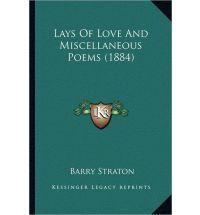Barry Straton

Barry Straton (poet, instructional writer, and journalist) was born 27 December 1854 in Fredericton, New Brunswick and died in 1901. Straton attended the local Collegiate School but did not pursue further formal education. In a bibliographical note, Theodore H. Rand states that Straton “studied law, but the confinement proving detrimental to his health, he resorted to farming” (403). Straton farmed in York County for many years and was married in October 1889 to Miss Leonora Margaret Harris. His political loyalties lay with the Conservative Party of Canada, and he believed in “looking for the higher education, socially, politically and morally, of the people” (Morgan 978).
Straton came from a family of poets. His maternal aunts were the mothers of Bliss Carman and Charles G. D. Roberts. In fact, Roberts occasionally wrote about his cousin in letters, commenting that, although Straton had a deficient education, he also had “a fine ear for melody” (qtd. in Bentley 1). The three cousin poets were also distantly related to Ralph Waldo Emerson, who was their mothers’ grandfather’s cousin. Straton’s father was a barrister who became a judge.
Straton had three books published: Lays of Love, and Miscellaneous Poems (1884), The Hunter’s Handbook (1885), and The Building of the Bridge: An Idyl of the River Saint John (1887). He also had many poems published in Fredericton’s University Monthly and in collections such as Rand’s A Treasury of Canadian Verse (1900) and Lawrence J. Burpee’s A Century of Canadian Sonnets (1910). William Douw Lighthall believed Straton was a “very promising poet” (Bentley 1), and Charles G.D. Roberts said Straton’s best poems were not in his books but those published by University Monthly (Bentley 1).
Lays of Love is representative of Straton’s poetry. Straton works with different forms in this collection, such as songs and sonnets. Most of his long poems are written in iambic pentameter, but he experiments with different meter and rhyme schemes in his shorter poems. He seems to delight in playing with internal rhyme, alliteration, and repetition. As the name of the collection implies, he is concerned with themes of love in its many forms. He writes about nature, war, loss, rural life, and the sea as well as Christian morals such as hope, charity, and faith. He uses images of Eden and the dove as symbols of a distant grandeur. He is similarly concerned with womanhood, purity, and chastity, as was the Victorian fashion and worldview of his time. Many of his poems are lighthearted and lyrical, reflecting the musical cadences of the Fredericton poets.
In the poem “Charity,” Straton writes, “Our hands should be fruitful and open. The field for our giving is wide, / And blessing shall follow the gifts, though the power to give may be small” (Lays of Love 80). This sentiment is both an example of largesse for Straton and a literary aesthetic, as the dedication in the front of Lays of Love suggests: “It is my intention to devote one half of my proceeds of the sale of this work to the service of the Poor of Fredericton, N.B.”
Along with “Charity,” “America” is one of Straton’s most often anthologized poems. In “America” Straton criticizes the notion that Columbus discovered the “New World” because the size of our landscape betrays such simple pronouncements. This poem is a tribute to North America and nature, revealing the poet’s belief in timelessness and vastness of space, not to mention his respect for our First Nations People.
Barry Straton loved the Saint John River. He often went on long outings with a canoe. The beauty of the river became the inspiration of many of his poems and the things he learned from nature became the basis for The Hunter’s Handbook. This is an instructional book for amateur hunters out for sport in the woods. He includes tips for cooking, performing camp chores, determining the weather according to the behavior of animals, treating common hunting predicaments such as near-drowning, cuts, and bug bites. It is a very practical guide, packaged in a compact form so that it may be carried into the woods. Straton explains in his introduction that many handbooks at the time were too large to take along and were better suited to a drawing room table.
Straton’s long poem, The Building of the Bridge, was written to commemorate the official opening of Fredericton’s first bridge across the Saint John River on 27 November 1885. The poem is “Respectfully Dedicated to the Hon. A.G. Blair, Attorney General of the Province of New Brunswick.” The poem has nineteen pages consisting of a “Poem to the River Saint John,” the fifteen-page body of the poem, and “L’envoi to the River Saint John.” Stanton remains more than a footnote to the work of Roberts and Carman, his beloved cousins. His best work equals their own in depth of feeling and musicality. He warrants greater interest.
Rebecca Rankin, Winter 2009
St. Thomas University
Bibliography of Primary Sources
Straton, Barry. “The Building of the Bridge.” D.M.R. Bentley, ed. Canadian Poetry. 2009. U of Western Ontario. 25 Oct. 2009
<http://canadianpoetry.org/>.
---. The Building of the Bridge: An Idyl of the River Saint John. Saint John, NB: J. &. A. McMillan, 1887.
---. The Hunter’s Handbook. Boston, MA: Lee and Shepard, 1885.
---. Lays of Love, and Miscellaneous Poems. Saint John, NB: J. &. A. McMillan, 1884.
Bibliography of Secondary Sources
Burpee, Lawrence J., ed. A Century of Canadian Sonnets. Toronto, ON: Musson Book Co., 1910.
Rand, Theodore H., ed. A Treasury of Canadian Verse with Brief Biographical Notes. Toronto, ON: W. Briggs, 1900.
“Straton, Barry.” A Bibliography of Canadian Poetry. Charles Canniff James, comp. Toronto, ON: William Briggs, 1899.
“Straton, Barry.” The Canadian Men and Women of the Time: A Hand-Book of Canadian Biography. Ed. Henry James Morgan. Toronto, ON: William Briggs, 1898.


